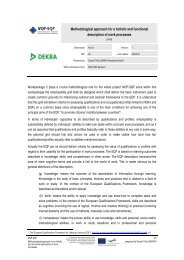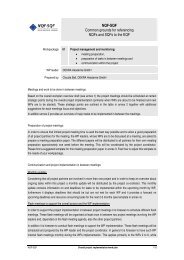Overview of National Qualification frameworks - Project-Nqf-Sqf
Overview of National Qualification frameworks - Project-Nqf-Sqf
Overview of National Qualification frameworks - Project-Nqf-Sqf
Create successful ePaper yourself
Turn your PDF publications into a flip-book with our unique Google optimized e-Paper software.
Another important question that is being looked into at present is connected to the legal status <strong>of</strong> theNQF. A working group dealing with legal aspects was set up at the Ministry <strong>of</strong> Education. It is workingout a proposal <strong>of</strong> whether and, if so, which legal framework should be given to the NQF. The proposalwill be presented at the next meeting <strong>of</strong> the NQF Steering Group in January 2011.The time schedule for the next steps in the NQF development process foresees that the proposedprocedure for classifying qualifications in the NQF (i.e. the criteria and procedure described in the abovementioned manual) will be tested in the first semester <strong>of</strong> 2011 (by “simulating “ classifications <strong>of</strong>selected qualifications. The concrete procedure will also be decided at the next NQF Steering Groupmeeting.All qualifications – irrespective <strong>of</strong> the focus (general education qualifications and VET qualifications)and the learning context (for example initial VET or continuous VET) – will be classified to theNQF. Due to the complexity <strong>of</strong> the NQF development process and the fact that different ministries,departments and stakeholders need to be involved it was decided to work on the ‘formalqualification area’ (comprising qualifications that are based on legal regulations, i.e. laws,directives, etc.) and the ‘non-formal qualification area’ separately. Although, for qualifications fromboth areas, the same classification principles will apply in the end, the starting situation, regardingstakeholders in charge and governance principles, differs. Thus, working groups deal with thequestions attached to both areas separately.Other open questions and challenges include:- Communication between the different segments <strong>of</strong> the qualifications system;- Question whether and to which extent the NQF should be used to support national reforms;- Relation with EHEA (Bologna process): Good cooperation will be needed to establishconditions for better progression possibilities between different subsystems;- Allocation <strong>of</strong> qualifications to the NQF level - open questions, e.g. the issues <strong>of</strong> partialqualifications or parts <strong>of</strong> qualifications, how to understand and apply the principle <strong>of</strong> best fit(clear classification <strong>of</strong> existing qualifications is difficult in many cases because the genericdescriptors <strong>of</strong> the EQF are underdetermined and do not allow a perfect fit), procedures andoperational structures;- Can all qualifications <strong>of</strong> the same types be allocated to the same levels?- Questions relating to the learning outcomes approach in terms <strong>of</strong> concepts and sound assessmentmethodologies and tools. Central questions: how to balance outcome orientation and inputfactors? And: Are learning outcomes to be implemented in a coherent way across differentsubsystems (general, VET and HE)?- Integration <strong>of</strong> qualifications acquired in non-formal learning contexts and validation <strong>of</strong> nonformalin informal learning in the NQF development; issue <strong>of</strong> equivalences <strong>of</strong> qualificationsacquired in different learning contexts;- Further involvement <strong>of</strong> stakeholders to strengthen ownership and commitment (the need toengage and include education and training providers and universities); the challenge is to findagreements within a justifiable time period in view <strong>of</strong> the different interests and objectives.




